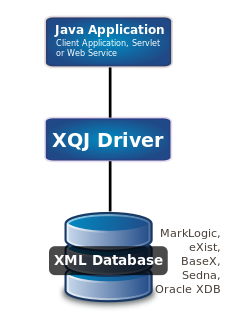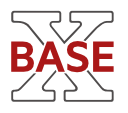XSLT is a language for transforming XML documents into other XML documents, or other formats such as HTML for web pages, plain text or XSL Formatting Objects, which may subsequently be converted to other formats, such as PDF, PostScript and PNG. XSLT 1.0 is widely supported in modern web browsers.
Saxon is an XSLT and XQuery processor created by Michael Kay and now developed and maintained by his company, Saxonica. There are open-source and also closed-source commercial versions. Versions exist for Java, JavaScript and .NET.
XPath 2.0 is a version of the XPath language defined by the World Wide Web Consortium, W3C. It became a recommendation on 23 January 2007. As a W3C Recommendation it was superseded by XPath 3.0 on 10 April 2014.
eXist-db is an open source software project for NoSQL databases built on XML technology. It is classified as both a NoSQL document-oriented database system and a native XML database. Unlike most relational database management systems (RDBMS) and NoSQL databases, eXist-db provides XQuery and XSLT as its query and application programming languages.
An XML database is a data persistence software system that allows data to be specified, and sometimes stored, in XML format. This data can be queried, transformed, exported and returned to a calling system. XML databases are a flavor of document-oriented databases which are in turn a category of NoSQL database.
The following tables compare XML compatibility and support for a number of layout engines.
The identity transform is a data transformation that copies the source data into the destination data without change.
XML documents have a hierarchical structure and can conceptually be interpreted as a tree structure, called an XML tree.
XQuery Update Facility is an extension to the XML Query language, XQuery. It provides expressions that can be used to make changes to instances of the XQuery 1.0 and XPath 2.0 Data Model.
TigerLogic Corporation designed, developed, sold and supported software infrastructure products. This software was categorized into the following product lines: yolink search enhancement technology, XML Data Management Server (XDMS), Multidimensional Data Management System (MDMS) and Rapid Application Development (RAD) software tools. TigerLogic was dissolved in 2016, with its multivalue database products being sold to Rocket Software, and its Omnis products being sold to UK-based OLS Holdings Ltd.
XPath is a query language for selecting nodes from an XML document. In addition, XPath may be used to compute values from the content of an XML document. XPath was defined by the World Wide Web Consortium (W3C).
In software development XRX is a web application architecture based on XForms, REST and XQuery. XRX applications store data on both the web client and on the web server in XML format and do not require a translation between data formats. XRX is considered a simple and elegant application architecture due to the minimal number of translations needed to transport data between client and server systems. The XRX architecture is also tightly coupled to W3C standards to ensure XRX applications will be robust in the future. Because XRX applications leverage modern declarative languages on the client and functional languages on the server they are designed to empower non-developers who are not familiar with traditional imperative languages such as JavaScript, Java or .Net.
XQuery is a query and functional programming language that queries and transforms collections of structured and unstructured data, usually in the form of XML, text and with vendor-specific extensions for other data formats. The language is developed by the XML Query working group of the W3C. The work is closely coordinated with the development of XSLT by the XSL Working Group; the two groups share responsibility for XPath, which is a subset of XQuery.
Sedna is an open-source database management system that provides native storage for XML data. The distinctive design decisions employed in Sedna are (i) schema-based clustering storage strategy for XML data and (ii) memory management based on layered address space.

XQuery API for Java (XQJ) refers to the common Java API for the W3C XQuery 1.0 specification.

BaseX is a native and light-weight XML database management system and XQuery processor, developed as a community project on GitHub. It is specialized in storing, querying, and visualizing large XML documents and collections. BaseX is platform-independent and distributed under a permissive free software license.

An XML transformation language is a programming language designed specifically to transform an input XML document into an output document which satisfies some specific goal.
Zorba is an open source query processor written in C++, implementing
Stylus Studio is an integrated development environment (IDE) for the Extensible Markup Language (XML). It consists of a variety of tools and visual designers to edit and transform XML documents and legacy data such as electronic data interchange (EDI), comma-separated values (CSV) and relational data.
JSONiq is a query and functional programming language that is designed to declaratively query and transform collections of hierarchical and heterogeneous data in format of JSON, XML, as well as unstructured, textual data.



